
The deadline for nominations is the week beginning 10 June.
One of the biggest issues for the candidates is where they stand on Brexit - an issue that has split the party and cost Mrs May her job.
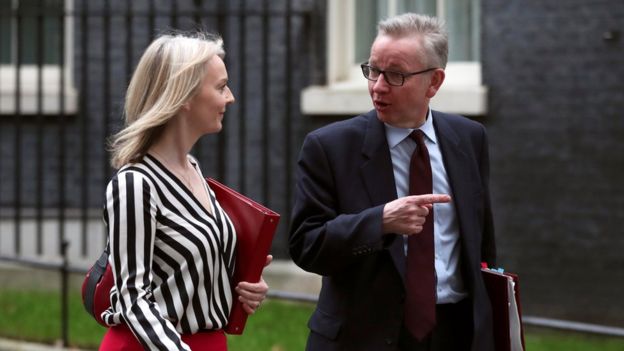 REUTERS
REUTERSMichael Gove
The environment secretary, and prominent member of the Leave campaign in 2016, has said he would consider a further delay to Brexit.
The UK is scheduled to leave the European Union (EU) on 31 October.
But Mr Gove says if a better deal is within reach by that date, then he would sanction a "short delay" to finalise it.
His plan would be to go back to Brussels and negotiate changes to the "backstop".
The backstop is the insurance policy, negotiated by the UK and the EU, to avoid a hard Irish border (a border with checks and infrastructure).
After Brexit, Northern Ireland and the Republic of Ireland could be in different customs and regulatory regimes, which could mean products being checked at the border.
To avoid this, the backstop would keep the UK in a customs union with the EU (until both sides reached a trade agreement that would avoid a hard border) - but this is controversial as it would prevent the UK from doing its own trade deals.
Mr Gove says he would also:
- aim for a free trade agreement (based on the deal between Canada and the EU, which took over seven years)
- guarantee the rights of EU nationals in the UK
- rule out a further referendum
- if it came down to a choice of no deal or no Brexit, choose no deal
Potential obstacles: The conclusions of the EU when it decided the UK could delay leaving until the end of October clearly states: "The European Council reiterates that there can be no opening of the withdrawal agreement." The withdrawal agreement is the legally binding part of the divorce deal, agreed by Theresa May and the EU, which contains the Irish backstop plan.
Sam Gyimah
The former universities minister is proposing a further referendum to break the impasse over the Brexit negotiations.
Mr Gyimah said the referendum would have two questions:
- Leave v Remain
- Theresa May's deal v no deal
He has said leaving with no deal would be "an abject failure".
Potential obstacles: The current Brexit extension runs out on 31 October. The EU may be open to granting another extension for the purpose of holding a further referendum. But Parliament voted in March against holding another referendum (the amendment lost by 27 votes).
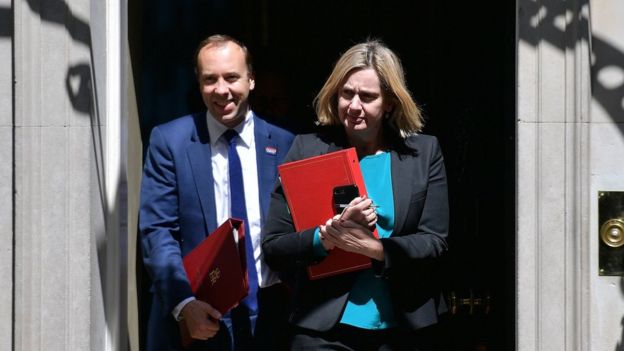 GETTY IMAGES
GETTY IMAGESMatt Hancock
The health secretary says leaving with no deal is not an option - so it's between leaving with a deal and not leaving at all.
Mr Hancock has set out a "Brexit delivery plan", which involves setting up an Irish Border Council to come up with a plan for avoiding a hard border in Ireland.
Mr Hancock has said he would "seek a time limit to the backstop".
He proposes negotiating a comprehensive free trade agreement, which would involve leaving the single market and the customs union.
He also says he would "enshrine the rights of EU citizens in law".
Potential obstacles: Putting a time limit on the backstop was suggested, under Theresa May, and was rejected by the EU (which argued that any time limit would mean it was no longer a backstop). A free trade agreement, alone, would not solve the problems at the Irish border.
Mark Harper
The former chief whip says it is "not credible" that a Brexit deal could be renegotiated with the EU and be passed by Parliament by 31 October - when the current extension period runs out.
He says he wants the UK to leave with a deal (which implies seeking a further extension) but leaving without one remains an option (if the alternative is not leaving at all).
He has said he would go to Brussels to negotiate changes to the backstop and this would involve "building strong relationships with the Republic of Ireland, both communities and all parties in Northern Ireland".
Potential obstacles: The backstop has proved one of the thorniest areas of negotiation in the past - Theresa May tried, and failed, to change it. And the EU has gone on record saying the Withdrawal Agreement will not be re-opened.
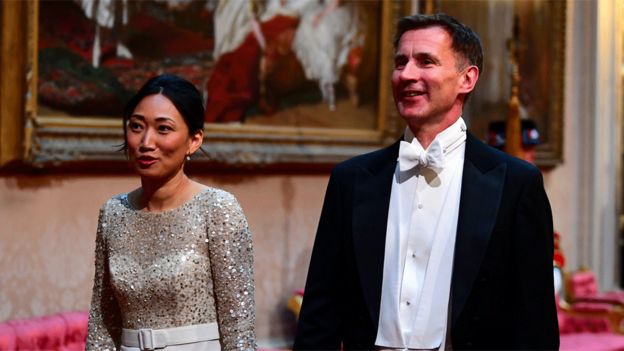 PA
PAJeremy Hunt
The foreign secretary says if the only way to leave the EU was with no deal then he would do that but it is not his preferred option.
Mr Hunt says there is a prospect of doing a better deal, he is in favour of changes to the Withdrawal Agreement, and he thinks it is possible to get them made by 31 October.
He also wants changes to the Irish backstop.
He proposes sending a new negotiating team team to Brussels, which would include representatives of the European Research Group (the group of Conservative MPs who support harder forms of Brexit) and members of Northern Ireland's Democratic Unionist Party.
Potential obstacles: When the EU granted a further Brexit delay (to 31 October), it said there could be no opening of the Withdrawal Agreement - the legally binding part of the divorce deal which contains the Irish backstop plan.
Sajid Javid
The home secretary has said he would also focus on the Withdrawal Agreement, with changes to the backstop.
He has talked about "a new digitised" Irish border, which could be "done in a couple of years" and that would not involve any infrastructure on the border.
He says he would make a "grand gesture" to the Irish government by paying for it.
Mr Javid has also said he cannot envisage circumstances in which he would want to have another extension to the UK's exit date.
And he says the country must prepare for a no-deal Brexit.
Potential obstacles: The EU has been clear it is not prepared to re-open the Withdrawal Agreement during the extension period. It's not clear exactly what Mr Javid means by a digitised border, although he says he has had Border Force working on the question, but the EU's deputy chief Brexit negotiator, Sabine Weyand, said in March that technology could not solve the border issue "in the next few years".
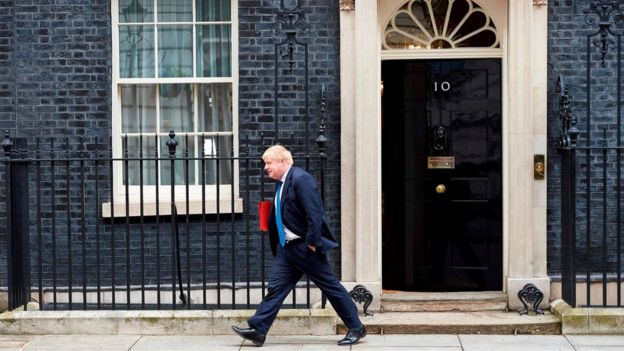 GETTY IMAGES
GETTY IMAGESBoris Johnson
The former foreign secretary wants to remove the Irish backstop plan from the Withdrawal Agreement but he has said the UK will leave on 31 October "deal or no deal".
Mr Johnson says the "way to get a good deal is to prepare for no deal".
But he also says a no-deal exit would cause "some disruption".
Mr Johnson suggested the solution to the current deadlock would be to replace the Irish backstop with "alternative arrangements" to avoid a hard border, so as to facilitate a "managed exit" from the EU.
Potential obstacles: A representative of the head of the European Council said at the end of January: "The backstop is part of the withdrawal agreement, and the withdrawal agreement is not open for re-negotiation." Preparing for no deal didn't enable Theresa May to get the changes she wanted to the withdrawal agreement and it's not clear how Mr Johnson can be confident of greater success.
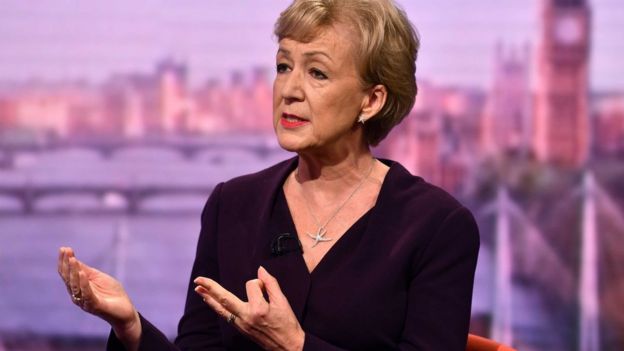
Andrea Leadsom
The former leader of the House of Commons is proposing what she calls a "managed exit" rather than a renegotiation.
She wants the UK to leave the EU on 31 October and has proposed a "three step plan for Brexit":
- She would introduce a bill to deal with the rights of EU citizens in the UK and another bill, which would include "sensible measures" already negotiated and agreed such as the status of Gibraltar and goods already in circulation
- She would "significantly ramp up preparations" for leaving the EU at the end of October, including working on "alternative arrangements" for the Irish border
- She would lead a delegation of ministers to speak to key EU leaders and the UK would convene a summit in early September with the EU to agree "sensible measures" to "ensure a smooth exit"
Potential obstacles: While EU countries have made unilateral arrangements for a no-deal Brexit, they have so far been unwilling to reach agreements with the UK for such a situation. Attempts to find alternative arrangements for the Irish border have been unsuccessful so far.

Esther McVey
The former work and pensions secretary says Britain needs a "clean break" from the EU on World Trade Organization (WTO) terms but if the EU made a better offer she would listen.
Miss McVey says if the EU is "truly faced with no deal" it could be "prepared to move away from their fixed position, listen, remove the backstop, and negotiate a free-trade deal".
Potential obstacles: Virtually no countries trade solely on WTO rules - they rely on dozens of agreements on top to make trade easier. If the UK left on WTO terms, it would have to renegotiate lots of deals, which would take time. Because the UK would no longer be in the EU single market and customs union, there would be checks on goods at borders, which would cause delays and economic disruption.
Dominic Raab
The former Brexit secretary says he would re-open the withdrawal agreement.
He says leaving on WTO terms "is far better than leaving with a fatally flawed deal" and he has refused to rule out proroguing Parliament (essentially shutting it down) ahead of the 31 October deadline to prevent it blocking a no-deal Brexit.
Mr Raab wants to "overhaul the backstop" and says his Brexit policy would be based on the "Malthouse compromise".
The proposal, drawn up by backbenchers from Leave and Remain wings of the Tory Party, would retain "the vast majority" of Mrs May's Brexit deal but replace the Irish backstop with "alternative arrangements" involving "advanced customs and trade measures" and checks away from the border.
Mr Raab says the UK-EU future relationship "must centre on a 'best in class' free trade agreement (such as the EU-Canada agreement), not a customs union or any other hybrid arrangement requiring close regulatory alignment".
Potential obstacles: The EU's Brexit negotiator, Michel Barnier, has said: "Alternative arrangements: technology, drones, invisible controls... none of these arrangements are operational today... you need technical infrastructure to do that. And this takes time." And - as already explained - the EU has consistently ruled out any replacement of the backstop. Leaving on WTO terms is another way of saying leaving with no deal. The government's own economic analysis says that could reduce the size of the economy by 9.3% after 15 years, compared with staying in the EU.
Rory Stewart
The international development secretary says a no-deal Brexit would be "catastrophic" and is "undeliverable" and "unnecessary".
Mr Stewart is advocating citizens' assemblies for Brexit to thrash out a compromise.
He is planning to focus on getting Theresa May's existing deal through Parliament as there is "no evidence" the EU will offer a different deal.
Potential obstacles: Attempts to get the existing deal through Parliament have been unsuccessful so far. Citizens' assemblies may well turn out to be just as divided on Brexit issues as Parliament or the country as a whole.